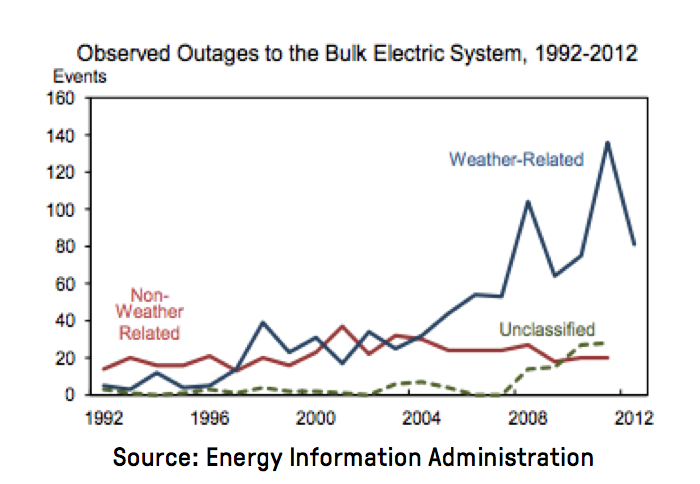By Jared Solomon, intern, in collaboration with Jennifer Kefer, Executive Director of the Alliance for Industrial Efficiency
2017 saw record storm damages — combined heat and power can help protect our future.
Catastrophic weather events are becoming more frequent, more intense, and more damaging to infrastructure and local economies. In fact, 2017 was the costliest year on record for weather events, with U.S. economic losses totaling $344 billion. For comparison, these losses are 93 percent higher than the average losses from natural catastrophes in 2000-2016. And we are seeing a marked increase in the number of billion-dollar disasters.
Many of these economic losses stem from power outages. A 2013 report from the President’s Council of Economic Advisers suggests that the average annual financial loss from power outages caused by extreme weather usually comprises around 30 percent of total losses, and can reach as high as 50 percent. Applying this historic pattern to 2017 disaster figures, U.S. economic losses from weather-based power outages could range from $100 billion to $175 billion.
The number of weather-related power outages has increased along with the growing number of disastrous weather events. This trend is expected to continue with increasing climate change. While we may not be able to prevent future storm events, we can make energy infrastructure more resilient, lowering the number of weather-related power outages and mitigating the costs of future disasters. To accomplish this, state and federal policymakers should direct disaster funds toward deployment of combined heat and power (CHP) technology.
 CHP uses the simultaneous, onsite generation of both heat and power to reach efficiency levels often exceeding 80 percent, and in many instances more than doubling the efficiency of conventional power generation (around 36 percent). These increased levels of efficiency have obvious benefits due to a diminished reliance on fuel, yet CHP also brings other major resiliency advantages. CHP systems can be designed to “island” themselves from the grid, meaning that when weather events knock out power, buildings with CHP can continue to function normally through below-ground natural gas lines. CHP is therefore an important tool to help make American infrastructure more resilient—by providing uninterrupted energy during storms, CHP systems can help mitigate the disastrous economic effects of these weather events.
CHP uses the simultaneous, onsite generation of both heat and power to reach efficiency levels often exceeding 80 percent, and in many instances more than doubling the efficiency of conventional power generation (around 36 percent). These increased levels of efficiency have obvious benefits due to a diminished reliance on fuel, yet CHP also brings other major resiliency advantages. CHP systems can be designed to “island” themselves from the grid, meaning that when weather events knock out power, buildings with CHP can continue to function normally through below-ground natural gas lines. CHP is therefore an important tool to help make American infrastructure more resilient—by providing uninterrupted energy during storms, CHP systems can help mitigate the disastrous economic effects of these weather events.
Congress is currently considering an $81 billion disaster relief bill—the largest single funding bill of its kind in U.S. history. The bill is meant to help Texas, Florida, Puerto Rico and the U.S. Virgin Islands rebuild after the devastation wrought by storms Harvey, Irma and Maria. While these disasters were tragic, the rebuilding process provides an opportunity to make American communities and economies less susceptible to future storm events. Accordingly, we urge both state and federal decision makers to encourage greater deployment of CHP in these rebuilding efforts.
As catastrophic weather events increase in frequency and intensity, we must act quickly to not only rebuild, but to do so in a way that strengthens our defenses against future catastrophes. CHP will help make U.S. infrastructure more resilient by reducing our dependence on a vulnerable grid. With a proven track record, CHP can help America use natural disasters as a catalyst for positive economic and environmental change and growth.
Read more about the opportunity for CHP in natural disaster mitigation in a new fact sheet from the Alliance.
